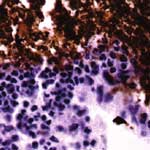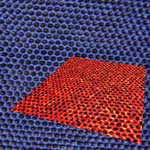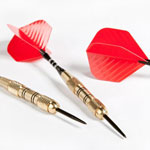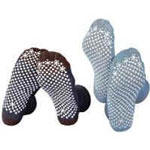Showing Spotlights 2001 - 2008 of 2855 in category All (newest first):
 Most products today are defined as 'nanotechnology product' because they contain nanoparticles in some form or other. For instance, many antimicrobial coatings contain silver in nanoscale form; food products and cosmetics contain nanoparticles; drug formulations are made with nanoscale ingredients; and some products are partially made with composite materials containing nanomaterials (e.g. carbon nanotubes or carbon nanofibers) to mechanically strengthen the material. Two researchers from the Norwegian National Institute for Consumer Research (SIFO), Harald Throne-Holst and Pal Strandbakken, argue that consumer rights in the nanotechnology age are not self-evident but rather have to be strengthened, partly redefined and certainly revived in order to empower and protect consumers.
Most products today are defined as 'nanotechnology product' because they contain nanoparticles in some form or other. For instance, many antimicrobial coatings contain silver in nanoscale form; food products and cosmetics contain nanoparticles; drug formulations are made with nanoscale ingredients; and some products are partially made with composite materials containing nanomaterials (e.g. carbon nanotubes or carbon nanofibers) to mechanically strengthen the material. Two researchers from the Norwegian National Institute for Consumer Research (SIFO), Harald Throne-Holst and Pal Strandbakken, argue that consumer rights in the nanotechnology age are not self-evident but rather have to be strengthened, partly redefined and certainly revived in order to empower and protect consumers.
Nov 17th, 2009
 Quite a number of serious medical conditions, such as cancer, diabetes and chronic pain, require medications that cannot be taken orally, but must be dosed intermittently, on an as-needed basis, and over a long period of time. By combining magnetism with nanotechnology, researchers have now created a small implantable device that encapsulates the drug in a specially engineered membrane, embedded with magnetic iron oxide nanoparticles. The application of an external, alternating magnetic field heats the magnetic nanoparticles, causing the gels in the membrane to warm and temporarily collapse. This collapse opens up pores that allow the drug to pass through and into the body. When the magnetic field is turned off, the membranes cool and the gels re-expand, closing the pores and halting drug delivery. No implanted electronics are required.
Quite a number of serious medical conditions, such as cancer, diabetes and chronic pain, require medications that cannot be taken orally, but must be dosed intermittently, on an as-needed basis, and over a long period of time. By combining magnetism with nanotechnology, researchers have now created a small implantable device that encapsulates the drug in a specially engineered membrane, embedded with magnetic iron oxide nanoparticles. The application of an external, alternating magnetic field heats the magnetic nanoparticles, causing the gels in the membrane to warm and temporarily collapse. This collapse opens up pores that allow the drug to pass through and into the body. When the magnetic field is turned off, the membranes cool and the gels re-expand, closing the pores and halting drug delivery. No implanted electronics are required.
Nov 16th, 2009
 Over the past decade, Atomic Force/Scanning Probe Microscopy (AFM/SPM) has emerged as the leading tool for investigations at the nanoscale - doing everything from imaging, to compositional differentiation, to explorations of molecular forces. But aside from some interesting tweaks, add-ons and repackaging, the field has seen no fundamentally new instruments for several years. For the extremely high-resolution AFM/SPMs, there has literally been no completely new microscope for well over a decade. Enter the new Cypher AFM. Cypher was designed from the ground up with a host of new features and unmatched performance enabled by its revolutionary new design.
Over the past decade, Atomic Force/Scanning Probe Microscopy (AFM/SPM) has emerged as the leading tool for investigations at the nanoscale - doing everything from imaging, to compositional differentiation, to explorations of molecular forces. But aside from some interesting tweaks, add-ons and repackaging, the field has seen no fundamentally new instruments for several years. For the extremely high-resolution AFM/SPMs, there has literally been no completely new microscope for well over a decade. Enter the new Cypher AFM. Cypher was designed from the ground up with a host of new features and unmatched performance enabled by its revolutionary new design.
Nov 12th, 2009
 A newly published antibacterial activity mechanism study demonstrates how a single walled carbon nanotube (SWCNT) kills bacteria by the physical puncture of bacterial membranes. The nanotubes would constantly attack the bacteria in solution, degrading the bacterial cell integrity and causing the cell death. This work elucidates several factors controlling the antibacterial activity of pristine SWCNTs and provides an insight in their toxicity mechanism. With regard to carbon nanotubes, in early toxicological studies, researchers obtained confounding results - in some studies nanotubes were toxic; in others, they were not. The apparent contradictions were actually a result of the materials that the researchers were using.
A newly published antibacterial activity mechanism study demonstrates how a single walled carbon nanotube (SWCNT) kills bacteria by the physical puncture of bacterial membranes. The nanotubes would constantly attack the bacteria in solution, degrading the bacterial cell integrity and causing the cell death. This work elucidates several factors controlling the antibacterial activity of pristine SWCNTs and provides an insight in their toxicity mechanism. With regard to carbon nanotubes, in early toxicological studies, researchers obtained confounding results - in some studies nanotubes were toxic; in others, they were not. The apparent contradictions were actually a result of the materials that the researchers were using.
Nov 10th, 2009
 One of the promises of medical nanotechnology is a drug-delivery nanodevice that can image, target, and deliver drugs to a specific cancer location inside the body and monitor and if necessary adjust the drug release at the target location. Researchers in Taiwan have now designed a nanodevice that comes pretty close to this vision. They have successfully demonstrated that our multifunctional drug-delivery nanodevice - a polymer core/single-crystal iron oxide shell nanostructure bonded to a quantum dot - can image, target, and deliver drugs via remote control. The device shows outstanding release and retention characteristics via an external on/off manipulation of a high-frequency magnetic field. Furthermore, the quantum dot bonded to the nanodevice provides optical information for in situ monitoring of the drug release.
One of the promises of medical nanotechnology is a drug-delivery nanodevice that can image, target, and deliver drugs to a specific cancer location inside the body and monitor and if necessary adjust the drug release at the target location. Researchers in Taiwan have now designed a nanodevice that comes pretty close to this vision. They have successfully demonstrated that our multifunctional drug-delivery nanodevice - a polymer core/single-crystal iron oxide shell nanostructure bonded to a quantum dot - can image, target, and deliver drugs via remote control. The device shows outstanding release and retention characteristics via an external on/off manipulation of a high-frequency magnetic field. Furthermore, the quantum dot bonded to the nanodevice provides optical information for in situ monitoring of the drug release.
Nov 9th, 2009
 New research reported this week has now established an industrially relevant process for assembling carbon nanotubes that allows them to efficiently be made into fibers, coatings and films - the basic forms of material that can be used in engineering applications. The most common of processing nanotubes into neat fibers - apart from 'dry' methods where they are spun directly into ropes and yarns - are 'wet' methods where CNTs are dispersed into a liquid and solution-spun into fiber. Currently, these processes yield fibers whose properties are not sufficiently close to optimal. Successful carbon nanotube assembly begins with control of dispersion and phase behavior and requires a scientific understanding of flow, colloidal interactions and solvent removal.
New research reported this week has now established an industrially relevant process for assembling carbon nanotubes that allows them to efficiently be made into fibers, coatings and films - the basic forms of material that can be used in engineering applications. The most common of processing nanotubes into neat fibers - apart from 'dry' methods where they are spun directly into ropes and yarns - are 'wet' methods where CNTs are dispersed into a liquid and solution-spun into fiber. Currently, these processes yield fibers whose properties are not sufficiently close to optimal. Successful carbon nanotube assembly begins with control of dispersion and phase behavior and requires a scientific understanding of flow, colloidal interactions and solvent removal.
Nov 5th, 2009
 The potential use of antimicrobial surface coatings ranges from medicine, where medical device infection is associated with significant healthcare costs, to the construction industry and the food packaging industry. Thin films which contain silver have been seen as promising candidate coatings. There now are even anti-odor, anti-bacterial socks that are treated with silver nanoparticles. Researchers in Switzerland have now examined what happens to these silver nanoparticle-treated textiles during washing. The scientists studied release of nanoparticles in laundry water from nine different textiles, including different brands of commercially available anti-odor socks. Studies like these will help address the question what the chances are of nanoparticles from nanofinished textiles being released into the environment.
The potential use of antimicrobial surface coatings ranges from medicine, where medical device infection is associated with significant healthcare costs, to the construction industry and the food packaging industry. Thin films which contain silver have been seen as promising candidate coatings. There now are even anti-odor, anti-bacterial socks that are treated with silver nanoparticles. Researchers in Switzerland have now examined what happens to these silver nanoparticle-treated textiles during washing. The scientists studied release of nanoparticles in laundry water from nine different textiles, including different brands of commercially available anti-odor socks. Studies like these will help address the question what the chances are of nanoparticles from nanofinished textiles being released into the environment.
Nov 4th, 2009
 The physical properties of nanostructures have been investigated extensively both theoretically and experimentally. Among these properties, melting temperature, superconductive temperature, Curie temperature and Debye temperature are key physical quantities since they are the characteristic temperatures of melting, superconduction, ferromagnetism and vibration. When the size of materials approaches the nanoscale, the surface-to-volume ratio increases and matter begins to behave exotically. Considering this, scientists can predict size effects on material properties from macroscopic laws, the so-called top-down approach. They present a general equation that is based only on the surface area to volume ratio of nanostructures and statistics (Fermi-Dirac or Bose-Einstein) followed by the particles involved in the considered phenomena (melting, ferromagnetism, vibration and superconduction).
The physical properties of nanostructures have been investigated extensively both theoretically and experimentally. Among these properties, melting temperature, superconductive temperature, Curie temperature and Debye temperature are key physical quantities since they are the characteristic temperatures of melting, superconduction, ferromagnetism and vibration. When the size of materials approaches the nanoscale, the surface-to-volume ratio increases and matter begins to behave exotically. Considering this, scientists can predict size effects on material properties from macroscopic laws, the so-called top-down approach. They present a general equation that is based only on the surface area to volume ratio of nanostructures and statistics (Fermi-Dirac or Bose-Einstein) followed by the particles involved in the considered phenomena (melting, ferromagnetism, vibration and superconduction).
Nov 3rd, 2009
 Most products today are defined as 'nanotechnology product' because they contain nanoparticles in some form or other. For instance, many antimicrobial coatings contain silver in nanoscale form; food products and cosmetics contain nanoparticles; drug formulations are made with nanoscale ingredients; and some products are partially made with composite materials containing nanomaterials (e.g. carbon nanotubes or carbon nanofibers) to mechanically strengthen the material. Two researchers from the Norwegian National Institute for Consumer Research (SIFO), Harald Throne-Holst and Pal Strandbakken, argue that consumer rights in the nanotechnology age are not self-evident but rather have to be strengthened, partly redefined and certainly revived in order to empower and protect consumers.
Most products today are defined as 'nanotechnology product' because they contain nanoparticles in some form or other. For instance, many antimicrobial coatings contain silver in nanoscale form; food products and cosmetics contain nanoparticles; drug formulations are made with nanoscale ingredients; and some products are partially made with composite materials containing nanomaterials (e.g. carbon nanotubes or carbon nanofibers) to mechanically strengthen the material. Two researchers from the Norwegian National Institute for Consumer Research (SIFO), Harald Throne-Holst and Pal Strandbakken, argue that consumer rights in the nanotechnology age are not self-evident but rather have to be strengthened, partly redefined and certainly revived in order to empower and protect consumers. 
 Subscribe to our Nanotechnology Spotlight feed
Subscribe to our Nanotechnology Spotlight feed





